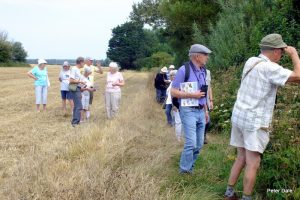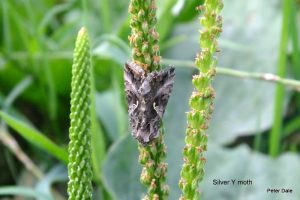Wasp Spider by Michael Blencowe for Sussex Wildlife Trust
I never thought I’d say this, but I’ve fallen in love with a spider. And coming from a lifelong arachnophobe that’s quite a claim. Whereas every other spider species sends me screaming in utter terror, the Wasp Spider has melted my heart. They are gorgeous. I met one on the South Downs last weekend and, hypnotised by her beauty, I spent hours with her; lying in the grass, staring lovingly into her eight eyes.
Wasp Spiders’ rotund abdomens are delicately patterned with exotic black, yellow and white stripes. Every Wasp Spider looks subtly different – as if each has been individually hand-painted. Their eight legs wear stripy black and white stockings – the sort favoured by the Wicked Witch of the East. This stripy, waspish appearance has given the spider its name and is used as a defence mechanism to ward off predators who equate this colouration with being stung.
They’re a relatively new resident in England. The first British Wasp Spider was found near Rye in 1922. Since then they have slowly spread across Sussex and you can find them in any areas of grassland. Here inside their long grass lair, they weave their silky circular webs which – like all spider webs – are a masterpiece of arachnoid architecture. As if proud of her accomplishment the Wasp Spider autographs her web with a unique silken squiggle. The actual purpose of this thick zigzag flourish (the ‘stabilimentum’) is a mystery; although some believe it reflects UV light, luring in pollinating insects who mistake the web for a flower.
Male Wasp Spiders don’t have it easy. Physically they lack any snazzy patterning and at 5mm are a third of the size of their hulking female counterparts. And when it comes to spider sex, she dominates the male too. During mating she turns her lover into lunch. So, as the female lies enticingly in her web, the male approaches her with understandable trepidation. It’s all about timing. After she slips out of her old exoskeleton and into something more comfortable, her fresh body is temporarily soft – and so are her jaws. This is her Achilles heel, an opportunity for the male to jump in, do his business and get out before being eaten. This sort of pressure would affect any fellas’ performance, but the male Wasp Spider has a trick up his eight sleeves: he can detach his sexual organs, leave them inside the female and scarper.
I always assumed that jettisoning his genitalia allowed the spider to survive, but almost every mating session ends in death for the male. Scientists have found that after this self-imposed castration, the spider’s sexual organs keep on fertilising the female and block other males’ attempts at mating. The spider sacrifices his own life to save his member and ensure he becomes a father. Wow, what a way to go.
Sussex Wildlife Trust is a conservation charity for everyone who cares about nature in Sussex. Founded in 1961, we have worked with local people for over half a century to make Sussex richer in wildlife.
We rely on the support of our members. Please consider joining us. Your membership will help us challenge decisions that threaten wildlife, care for more than 30 nature reserves, and inspire the next generation about the wonders of the natural world. It’s easy to join online at sussexwildlifetrust.org.uk/join


